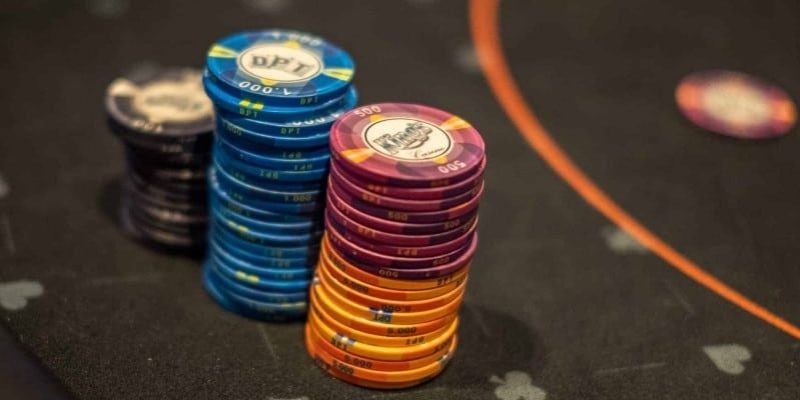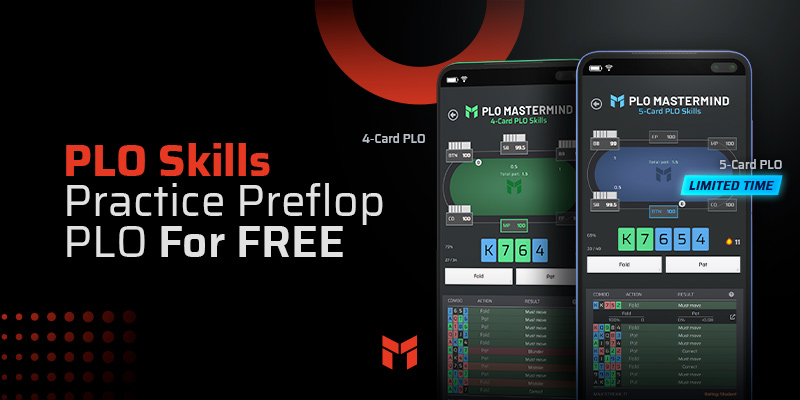PLO bankroll management is not just about keeping enough buy-ins to avoid losing your money in poker, but also about maximizing your hourly rate and climbing up stakes while capping your downside.
No matter how good your abilities are if you don’t learn proper bankroll management, you will go broke. That’s why you should learn the key components of PLO bankroll management.
Be prepared to head into this venture not only with the right bankroll but also with the right mindset, because when variance hits you it’s easy to lose your cool, go on tilt and make massive strategical mistakes.
Bankroll management is different for everyone.
To begin with, a one-size-fits-all approach to PLO bankroll management simply isn’t going to work out.
Each person has a different risk profile. Everyone has different personalities, poker goals, and motivations. This means that it’s hard to provide generic bankroll advice on how many buy-ins “you need” to be able to play a specific stake.
If you play non-professionally, a lot of it depends on your income and on how much money you are willing to “spend” on poker. If you play recreationally and you don’t mind adding some money to your bankroll if a risky move turned out bad, you might not need a strict approach.
It’s still recommended that you play within your means, at tables where you see other players making big mistakes, and that you only play with money you can lose.
If you are a professional and can’t add to your poker bankroll from other income sources, you need to minimize your risk of ruin. Because of this, you should use a standard rule of at least 100 to 150 buy-ins to account for variance and downswings.
If you can be confident that you are a strong winner at your regular game because you can see the edge difference and quality of decisions made at the table, you can be less strict and go as low as 50 buy-ins.
That said, going this route means you’ll need to be more aware of your mental state and make a bigger effort to find softer games
1. PLO Win Rates
Your win rate is the ultimate indicator of your success in poker and has a crucial effect on how aggressive your bankroll management can be.
It is a calculation of how much you are winning relative to a certain amount of hands. A typical example of this would be an average of 10/100, which means you win 10 big blinds per every 100 hands you play.
In the following image, you see how your win rate is constructed. Your net win rate is the final number and is determined by subtracting the effective rake from your true win rate.
TRUE WIN RATE | |
– | EFFECTIVE RAKE |
NET WIN RATE |
True Win Rate
Your true win rate reflects how you perform against the competition at a given site and how the cards are dealt. True win rate is largely affected by the level of competition.
Effective Rake
Effective rake is what’s left after subtracting the poker site bonuses and rakeback money from the rake paid at the tables.
RAKE PAID | |
|---|---|
– | FIRST-DEPOSIT BONUS |
– | RAKEBACK |
– | RAKE RACE / CHASE VALUE |
EFFECTIVE RAKE |
Comparing effective rake numbers among poker sites will give you an idea how multiple factors play a role determining your win rate.
Net Win Rate
Your net win rate amounts to the total money earned. You don’t just want the highest true win rate, you want the maximum net win rate, earning the most money possible.
You can boost your true win rate by improving your game from a strategic and/or mental game perspective, and by using tactics to select the best games.
Picking the right poker site determines the factors for your effective rake and is key to maximizing your net win rate. If you need any help choosing the best poker site for you, check out this article with our top recommendations to play PLO.
To continually maximize your win rate, be on your toes about the environment you play in and keep a dynamic approach to the ever-changing circumstances.
2. PLO Variance
Understanding variance is one of the biggest factors that make a PLO poker player successful. And if you want to become a winner, it’s a skill you must master.
Simply put, variance is the representation of how much results can differ from our expectations. This can happen often, and it can be extremely frustrating.
Variance is a big part of the game, and in most cases, your edge will be impacted by how well you run. Very often, players who are losing money will play worse, and because of this, they can lose their edge and become losing players in the games they are usually winning.
To protect yourself from ending in this minus EV situation, use a variance calculator to help you judge your situation more objectively.
In the following video clip, we outline examples of variance using Primedope’s free Poker Variance Calculator.
Stop thinking about yourself as either a winning player or a losing player. Look at it in terms of expected value. Look at the view of both players, and then correct that EV. You’re going to make money in the long run even if you lost that particular hand.
Additionally, the following tactics could also help you reduce your variance in Pot-Limit Omaha:
- Run it multiple times when you go all-in
- Playing against weaker opponents or soft games
- Consider short stacking, especially when taking shots (if you’ve trained for that specific strategy)
3. PLO Downswings
A downswing occurs whenever your current state of winnings is smaller than the peak that was previously achieved.
It’s important that you realize that a big downswing can happen to anyone. And, if you’re switching from Texas Hold’em to PLO, you should be mentally prepared to endure even bigger downswings.
In the following video clip, we go through simulations of downswings using Primedope’s free Poker Variance Calculator.
Sometimes it’s not a downswing. Sometimes you actually are a losing player, but you’re losing a lot more than you’re supposed to. Maybe you lost because you’re not playing well, but it’s just as likely that you actually played well, but variance is hitting you in the face.
The best way to know whether you are in a downswing or just losing because of poor strategy is to recognize your opponents’ mistakes and be aware of your own thought process.
Just imagine how you could be affected when you are losing for 3 months straight. Such a losing streak might affect your strategy so much that you end up extending your downswing.
That’s why working on your mental game is so important.
When you are losing after such a sample or period, it can be very tempting to quit playing entirely because you feel like you are a losing player, and it might feel like there is nothing you can do that will change this.
You’re not going to play in each stake until you lose all your money. You’re going to move down in stakes gradually, trying to recoup it.
In reality, the only thing that you can do to improve your chances of getting out of a downswing is to keep playing more hands and to keep constantly improving.
Focus on what is actually important, which is to improve your strategy and make sure that you show up with a clear mind whenever you play, to execute your A-game, and gradually improve at the same time.
4. Climbing Up Stakes
Everyone knows the stories of players who get knocked out of poker because they lose their entire bankroll in just one or two sessions.
Being conservative helps minimize your risk of losing your income due to having to drop back down in stakes, and it will also prevent you from having mental game issues because you are under-rolled.
You shouldn’t automatically climb to the next stake every time you get to 100 buy-ins for it. Instead, decide whether you should take a shot at higher stakes, then find a good scenario to do it.
You never want to just take a shot. You want to take the perfect shot.
Taking a shot at higher stakes is a high risk – high reward scenario. To justify it, you should look for situations where you have a big edge.
When you are taking a shot, you want your success rate to be as high as possible. Focus on playing as well as you can, move down when you lose the money that you set aside for the shot, and try it again if you fail.
Take the shot when your mental game is at its finest, when there are a lot of recreational players online, and when the regulars that are online are not playing their A-game.
If you can make these factors come together, it truly is a shot worth taking, and that is how you maximize your chances to successfully move up to the next stake.
It will take some time to get used to the new stake because you are facing new players, and you need to adjust to playing for larger sums of money.
Conclusion
To keep your bankroll in check, you have to take variance, your mindset, and your win rate into account.
The key is not exposing yourself to too much risk and making sure you can maintain the level of confidence you need to play your A-game as often as possible. This means making adjustments when needed, like going down a stake or playing at softer tables if necessary.
Focus on making the best decisions at each point of each hand. Study strategy, and execute it.
That’s all you can do, and that’s all you must do.



